Laterality in Sports: Theories and Applications
Editat de Florian Loffing, Norbert Hagemann, Bernd Strauss, Clare MacMahonen Limba Engleză Hardback – 25 aug 2016
- Describes the neurophysiological foundations of handedness
- Discusses the origins and development of laterality in humans
- Summarizes the impact of laterality on motor control and sports performance
- Encompasses research on both individual and team sports
- Includes research on skill acquisition, coaching, and development of expertise
- Covers research on laterality in preferred hand, foot, and eye use in sports
Preț: 460.51 lei
Preț vechi: 533.99 lei
-14% Nou
Puncte Express: 691
Preț estimativ în valută:
88.12€ • 92.00$ • 72.93£
88.12€ • 92.00$ • 72.93£
Carte tipărită la comandă
Livrare economică 29 martie-12 aprilie
Preluare comenzi: 021 569.72.76
Specificații
ISBN-13: 9780128014264
ISBN-10: 0128014261
Pagini: 380
Ilustrații: black & white illustrations
Dimensiuni: 152 x 229 x 24 mm
Greutate: 0.73 kg
Editura: ELSEVIER SCIENCE
ISBN-10: 0128014261
Pagini: 380
Ilustrații: black & white illustrations
Dimensiuni: 152 x 229 x 24 mm
Greutate: 0.73 kg
Editura: ELSEVIER SCIENCE
Cuprins
1. Laterality in Sports: More Than Two Sides of the Same Coin
Section A. Laterality – An Important and Often Disregarded Topic
2. Origins, Development, and Persistence of Laterality in Humans
3. In Fencing, Are Left-Handers Trouble for Right-Handers? What Fencing Masters Said in the Past and What Scientists Say Today
4. Measurement of Laterality and Its Relevance for Sports
5. Laterality and Its Role in Talent Identification and Athlete Development
6. Perspectives From Sports Medicine
Section B. Motor Control and Learning
7. What Can We Learn About Cognition From Studying Handedness? Insights From Cognitive Neuroscience
8. Laterality of Basic Motor Control Mechanisms: Different Roles of the Right and Left Brain Hemispheres
9. Effector Transfer
10. Near Misses and the Effect of Attentional Asymmetries on Sporting Performance
Section C. Performance in Sports
11. Laterality in Individualized Sports
12. Performance Differences Between Left- and Right-Sided Athletes in One-on-One Interactive Sports
13. Biomechanical Considerations of Laterality in Sport
14. Laterality Effects on Performance in Team Sports: Insights From Soccer and Basketball
15. Skill Acquisition in Left- and Right-Dominant Athletes: Insights From Elite Coaching
Section A. Laterality – An Important and Often Disregarded Topic
2. Origins, Development, and Persistence of Laterality in Humans
3. In Fencing, Are Left-Handers Trouble for Right-Handers? What Fencing Masters Said in the Past and What Scientists Say Today
4. Measurement of Laterality and Its Relevance for Sports
5. Laterality and Its Role in Talent Identification and Athlete Development
6. Perspectives From Sports Medicine
Section B. Motor Control and Learning
7. What Can We Learn About Cognition From Studying Handedness? Insights From Cognitive Neuroscience
8. Laterality of Basic Motor Control Mechanisms: Different Roles of the Right and Left Brain Hemispheres
9. Effector Transfer
10. Near Misses and the Effect of Attentional Asymmetries on Sporting Performance
Section C. Performance in Sports
11. Laterality in Individualized Sports
12. Performance Differences Between Left- and Right-Sided Athletes in One-on-One Interactive Sports
13. Biomechanical Considerations of Laterality in Sport
14. Laterality Effects on Performance in Team Sports: Insights From Soccer and Basketball
15. Skill Acquisition in Left- and Right-Dominant Athletes: Insights From Elite Coaching
Recenzii
"...an extremely well-written and thought-provoking book that explains more complex issues in sports performance, rehabilitation, injury prevention, and neurocognition in a very readable format...While the book is geared toward individuals in an academic setting, it can be useful for individuals in a variety of fields such as kinesiology, physical therapy, rehabilitation, neuropsychology, and sports performance." --PsycCRITIQUES















